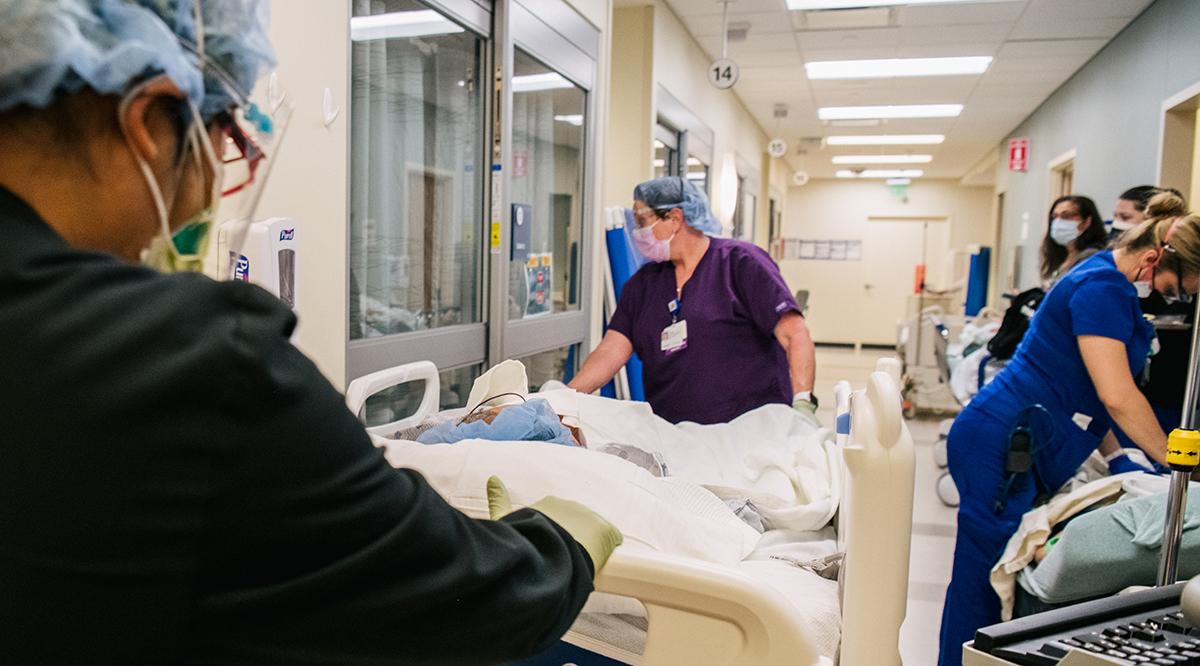In Houston, ambulances with patients in need of urgent care have been idling for hours outside emergency departments. In New Orleans, COVID-19 hospitalizations have already eclipsed last winter’s peak. And in Tampa, doctors who normally work in outpatient settings are making rounds as hospitalists.
Leaders at teaching hospitals in regions currently facing COVID-19 surges driven by the highly infectious delta variant describe the situation in their hospitals as the worst it’s been during the pandemic, despite hopes earlier this summer that the vaccination of large portions of the elderly and most vulnerable populations would keep hospitalizations in check.
“Hospitals are approaching a breaking point,” says James McDeavitt, MD, executive vice president and dean of clinical affairs at Baylor College of Medicine in Houston.
Despite more than 70% of adults in the country having received at least one COVID-19 vaccine dose and 81% of people 65 and older being vaccinated, a dramatic spike in infections among unvaccinated younger people, coupled with staffing shortages, is testing the surge plans hospital systems developed for previous waves.
“This fourth surge is now becoming the worst surge we’ve seen,” says Leonardo Seoane, MD, senior vice president and chief academic officer for Ochsner Health in New Orleans and associate vice chancellor of academics at LSU Health Shreveport. “The team is feeling like it’s another Hurricane Katrina.”
Hospitalization rates spiking
In the United States, hospitalizations due to COVID-19 reached a rate of 3.43 per 100,000 people as of Aug. 16, the highest it’s been since January though still below the winter peak of almost 5 per 100,000 people.
But the hospitalizations are far from evenly distributed. The two U.S. Department of Health and Human Services-designated health regions that include the Southern and Southwestern states — including Florida, Louisiana, and Texas — are recording hospitalization rates at least twice as high as any other health region, according to data from the Centers for Disease Control and Prevention.
Texas reached a hospitalization rate of nearly 6 per 100,000 people in mid-August, Louisiana had almost 8 per 100,000, and Florida reached a pandemic high of more than 10 per 100,000 people, nearly double the rate it experienced during last winter’s surge.
“At Tampa General, we’re busier than we’ve ever been,” says Charles Lockwood, MD, senior vice president of USF Health in Tampa, Florida, and dean of the USF Health Morsani College of Medicine.
Although deaths from COVID-19 have stayed low compared with earlier in the pandemic — thanks in part to better treatment protocols and the vaccination of older, sicker people — those who are being hospitalized now are younger, and some did not have medical conditions that put them at higher risk.
“The average age of admission has dropped by more than a decade,” McDeavitt says.
“The new risk factor [for severe, life-threatening COVID-19] is, ‘I’m not vaccinated.’”
Charles Fox, MD, chief medical officer for Ochsner/LSU Health System of North Louisiana
At Ochsner Health in New Orleans, the average age of patients admitted for COVID-19 is 50, and hospitals are seeing more people in their 20s, 30s, and 40s. In Shreveport last week, six patients were on extracorporeal membrane oxygenation (ECMO) machines, which bypass the heart and lungs of the sickest patients to give their bodies a chance to rest.
“It’s the most we’ve ever had,” says Charles Fox, MD, chief medical officer for Ochsner/LSU Health System of North Louisiana. “I don’t think anyone is over 45, and four had no risk factors.
“The new risk factor is, ‘I’m not vaccinated.’”
These COVID-19-related hospitalizations are on top of all the non-COVID-19 hospitalizations, which administrators say have also increased, in part because some people put off medical care earlier in the pandemic.
“I suspect a lot of people didn’t get medical care during 2020,” says Kencee Graves, MD, associate chief medical officer and associate professor of hospital medicine and palliative medicine at the University of Utah Health. “We need to be able to care for those that need us. COVID absolutely makes that harder.”
Even in places that are not experiencing steep COVID-19 surges, like New Mexico and Utah, hospitals are strained.
“At UNM [University of New Mexico] hospitals, we are experiencing very high volumes of patients. We’re well over capacity,” says Irene Agostini, MD, chief medical officer of UNM Hospital in Albuquerque. “We’ve been seeing an enormous influx of patients from around the state. … We’re surmising that these people can’t be cared for at the more rural hospitals.”
Staffing challenges
“The main difference [between this surge and previous ones] is that we are very challenged because of staffing,” says Roberto de la Cruz, MD, chief medical officer of Parkland Health and Hospital System in Dallas. On a recent weekend, the health system had to close more than two dozen beds because there weren’t enough nurses to staff them all.
Across the United States, health care workers — particularly nurses and respiratory therapists — have been quitting their jobs due to burnout or trauma from watching so many patients die or to pursue other opportunities.
Some nurses have quit their jobs to work in higher-paying markets or to sign up with traveling nursing agencies, which contract with hospitals and often offer higher compensation.
“Health care providers never got a break,” McDeavitt says. “We’ve had nurses say, ‘I quit; I’m going home; I can’t do this anymore.’ We’re seeing people just resign because they’ve had enough.”
Many nurses, particularly those with young children, have decided they don’t want to go through another year of trying to arrange child care and are even more worried about infecting their kids as more children are getting sicker from the delta variant, says Fox.
And with vaccines now available that largely prevent hospitalization from COVID-19, many health care workers are feeling particularly frustrated by continually seeing unvaccinated people suffer with the disease.
“Health care providers never got a break. We’ve had nurses say, ‘I quit; I’m going home; I can’t do this anymore.’ We’re seeing people just resign because they’ve had enough.”
James McDeavitt, MD, executive vice president and dean of clinical affairs at Baylor College of Medicine in Houston
“We’re having to go through tremendous sacrifice — deal with death and dying, the emotional toll for a completely preventable disease,” Seoane says.
Hospitals are now looking to state and federal governments to help call in reinforcements, in some cases by deploying military nurses to overwhelmed regions or by providing funding for traveling nurse contracts. But in the meantime, they are having to stretch their resources.
This means in some areas, intensive care units that would normally have one nurse to every one or two patients will now have one nurse tending to three patients, McDeavitt says. In other places, medical residents are treating more COVID-19 patients than early in the pandemic, and medical students are helping with tasks such as communicating with the families of patients and staffing clinics to free up nursing staff for more critical care.
“[The students] really are more engaged than ever, and they are really helping us,” Fox says.
But many health care leaders worry that as K-12 schools reconvene this month, potentially driving up case counts even more, the strain will only increase, putting those health care workers who remain on the front lines at even more risk of burning out.
“They leave their families every day, work long hours, they’re dedicated in their work,” Seoane says. “They seem indefatigable, [but] the truth is … [they] can only run on adrenaline for so long.”
A plea for solidarity
As COVID-19 cases continue to rise, hospital administrators worry that even worse days are ahead for their hospital systems and are pleading with the public to change their behavior to control the spread of the virus.
They are forging ahead with efforts to vaccinate those who remain unvaccinated. At Parkland Health and Hospital System in Dallas, clinicians get an alert if the patient they are seeing is unvaccinated to remind them to talk with them about any concerns or questions they might have about the vaccines. In Shreveport, health officials enlisted the help of players from the New Orleans Saints NFL team to promote vaccination. And in Tampa, they are doubling down on community outreach programs to vaccinate people in communities that have low vaccination rates, particularly people living in rural areas and Black and Latino people.
The efforts are paying off. Louisiana and Florida have seen upticks in vaccinations over the past month. In Louisiana, the seven-day average of vaccine doses administered has more than doubled, from 7,741 on July 20 to 15,919 on Aug. 17. Florida increased its seven-day-average doses from 42,476 on July 20 to 68,239 on Aug. 16, although that number dropped again in recent days, according to CDC data.
But the relief the vaccines will provide may not come soon enough. Hospital leaders are urging the public to band together in solidarity, not only for their own health and the health of those around them, but for the health care workers being pushed to their limits.
“We need masks and social mitigation, and the public needs to change their behavior; that’s the only thing that’s going to decrease hospitalizations over the next three weeks,” Seoane says. “We don’t have four to five weeks [to wait for vaccines to take effect]. The hospitals would absolutely be overrun.
“The public seems to go about their day-to-day life without any concept of what a true crisis this is."

